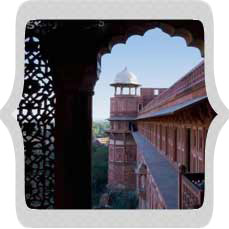The rest house in the Taj Mahal complex is an integral part of the structure. Find out more on the Rest House in Taj Mahal of Agra, India.
Taj Mahal Rest House
 |
The entire structure of the rest house bears many similarities to the mosque at the opposite end. Just like the mosque, it is made up of red sandstone with marble facing that provides a captivating contrast of colors, possesses one dominant portal known as the Iwan with one mini Iwan on either side of it, three marble coated domes surmounted by gilded finials and adorned with flower-topped pinnacles and traditional lotus design, and four little domed kiosks with marble veneer. The finial that we see today was installed in 1940 and is fourth in succession after a series of repairs and replacements. The first was replaced back in the year 1810 by Captain Joseph Taylor. And as it didn't serve as a mosque, the Quranic inscriptions that present in the mosque have here been replaced by floral designs and other decorative patterns done on white marble that infuse liveliness to the red sandstone background.
However, till date, there's a sense of ambiguity to what purpose the rest house served. Apart from accepted belief that it was built to provide a symmetrical balance to the proceedings, theories from experts differ from it being used to accommodate visitors for observing the death anniversaries of Mumtaz Mahal to it being used as a rest house for the pilgrims who came here on caravans. Some also believe that it was used as an assembly hall where devotees used to gather before prayer. Despite all the theories that are up and running, one thing is for certain that the sense of grandeur has certainly increased manifold by the symmetrical design and identical twins of outlying buildings, the rest house being one of them.